Ah, the joys of having a swimming pool—cooling off on hot summer days, relaxing swims, and fun pool parties.
But let’s be real, there’s also the never-ending battle against leaves that make their way into your oasis.
If you’re tired of trying countless methods of how to get leaves out of pool without fruitful end result every time you want to take a dip, you’re not alone.
Foliage in your pool isn’t just an eyesore; it’s a breeding ground for bacteria, disrupts your pool’s chemical balance, and can even damage your filtration system.
So, the cleanliness of your pool isn’t just about making it look inviting—it’s vital for proper maintenance and, more importantly, for your health.
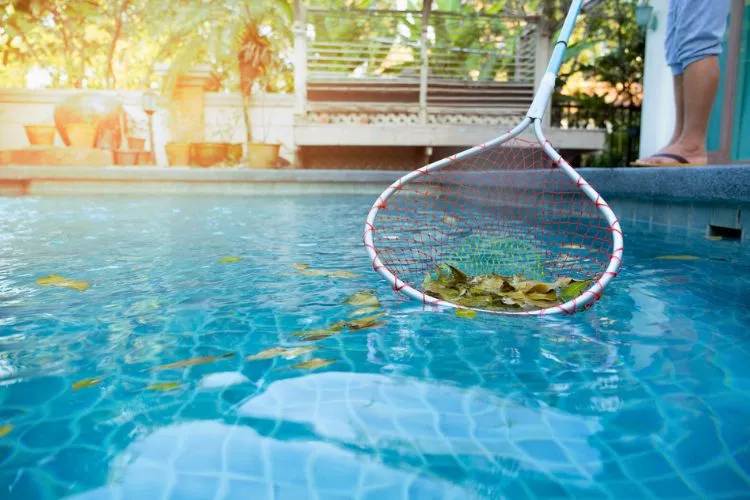
Stick around, because this comprehensive guide will walk you through proven techniques on how to get leaves out of your pool, turning this chore into a breeze. Trust me, your future self, not to mention your pool, will thank you!
Table of Contents
Understanding the Problem
Before we jump into the nitty-gritty of leaf removal, it’s crucial to comprehend why leaves in the pool are more than just an aesthetic nuisance.
Causes of Leaf Accumulation
First off, let’s talk about why your pool becomes a leaf magnet in the first place. Understanding the root causes can be the first step toward efficient and effective leaf management.
Wind, nearby trees, and landscaping
If your pool is surrounded by tall trees or intricate landscaping, you’ve basically rolled out the welcome mat for leaves. Wind is another culprit. A brisk breeze can send leaves flying right into your pool, especially if your trees are deciduous types that shed leaves.
Some trees are more problematic than others; for example, a willow or maple tree located just a few yards (or meters) away can contribute to a heavy leaf load in no time.
Seasonal changes and weather patterns
Don’t overlook the impact of the seasons. Autumn is an obvious time for leaf-fall, but seasonal winds and storms can bring leaves into your pool year-round. Plus, different types of trees shed at various times of the year, not just in fall.
Paying attention to weather forecasts and understanding your local climate can give you the upper hand in preventing leaf accumulation.
Negative Impact of Leaf Buildup
Now that we’ve pinned down the likely culprits behind the leaf invasion, let’s shift our focus to why you should be concerned about this seemingly minor inconvenience.
Clogging of pool filters and drains
Imagine trying to sip a thick smoothie through a narrow straw. That’s essentially what happens when leaves clog your pool filters and drains.
Your pool’s filtration system has to work overtime, which is neither energy-efficient nor good for the equipment. Plus, a clogged drain can lead to water stagnation, creating a lovely home for algae and bacteria.
Reduction of water quality and chemical balance
Leaves aren’t just inert objects; they decompose. As they break down, they can throw off the pH levels of your pool water, making it more acidic or alkaline.
This can wreak havoc on your pool’s chemical balance, which is critical for killing bacteria and keeping the water safe for swimming.
Aesthetic and functional issues
Let’s not discount the power of first impressions. A pool scattered with leaves just isn’t as inviting. But beyond aesthetics, accumulated leaves can create slick, unsafe surfaces, making your pool a hazard zone rather than a relaxation spot.
Essential Tools and Equipment
Having the right tools for the job can transform your leaf-removal efforts from a chore into a simple task.
In this section, we’ll examine the must-have equipment to keep your pool leaf-free and ready for a refreshing plunge at any time.
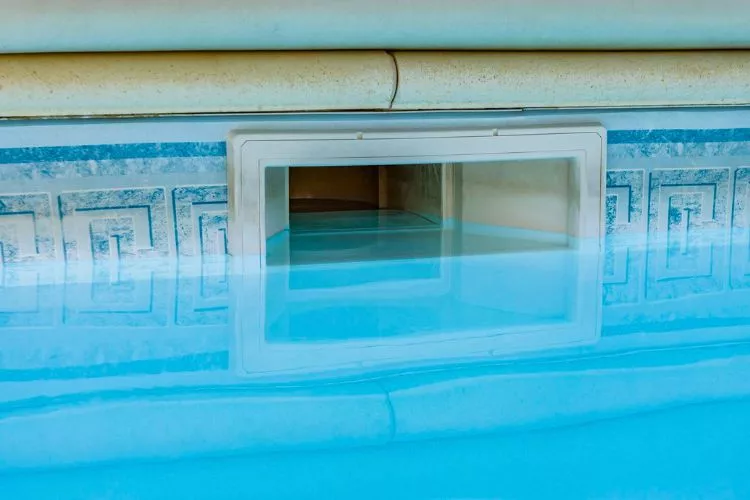
Pool Skimmers
In your quest to reclaim your pool from leafy invaders, the pool skimmer will be your loyal ally. This section will dive into the types of skimmers you can deploy and the role they play in debris removal.
Different types of skimmers available
Skimmers come in various forms, each with their own pros and cons. The most common are manual skimmers, which you operate by hand, and automatic skimmers that can be built into the pool’s circulation system or float freely.
There are also solar-powered skimmers, which use solar energy to move around the pool and collect debris. Picking the right skimmer boils down to the size of your pool and the extent of the leaf problem.
Their function in removing floating debris
No matter the type, the skimmer’s main job is to remove floating debris—leaves, of course, but also insects, twigs, and even small toys that find their way into the pool.
Skimmers work by creating a flow of water that pulls in floating objects into a collection basket. Emptying this basket regularly ensures that your skimmer operates at peak efficiency.
Pool Nets
For those moments when you need to go into hand-to-leaf combat, pool nets are your weapon of choice. They’re versatile, easy to use, and perfect for targeted leaf removal. Let’s explore the different kinds of nets you can use and the best practices for wielding them.
Various types of nets suitable for different leaf sizes
- Flat Nets (Leaf Skimmers): These are excellent for skimming leaves from the surface of the water.
- Bag Nets: Designed like a deep pocket, these are your go-to for scooping leaves off the pool floor.
- Mesh Size:
- Small mesh: Ideal for capturing tiny leaves and other small debris.
- Large mesh: Better suited for larger leaves that are more stubborn to catch.
How to effectively use a pool net
- Start at One End: Begin at one end of the pool to ensure you don’t miss any spots. This will make your leaf removal more systematic and efficient.
- Choose the Right Net: Before you start, make sure you’ve chosen the appropriate net type and mesh size based on the kinds of leaves you’re dealing with.
- Use Slow, Smooth Motions: Rapid or jerky movements can create water currents that push leaves away from the net. Slow and smooth dragging or scooping motions are more effective.
- Skim Then Scoop: If there are leaves both on the surface and the bottom, start by skimming the surface. This will prevent the surface leaves from sinking and adding to your bottom-layer problem.
- Empty the Net Regularly: The heavier your net gets, the more cumbersome it becomes to handle. Make it a point to regularly empty the net into a waste bag or compost pile.
- Check Corners and Edges: Leaves often get trapped in the corners or stick to the edges. Don’t forget these often-overlooked areas.
- Two-Handed Technique: For better control and balance, especially with bag nets, using both hands can be more effective.
- Rinse the Net: After you’re done, give the net a good rinse to remove any lingering chemicals or debris, extending the life of your net.
Leaf Rakes
When pool nets and skimmers won’t cut it, and you need the heavy artillery, that’s where leaf rakes come in. Designed to tackle substantial leaf problems, these tools are a must-have for any serious pool owner.
Let’s delve into what makes these rakes unique and how you can choose the right one for your pool.
Purpose and design of leaf rakes
Leaf rakes for pools are specialized tools with a much broader and deeper net compared to pool nets. They are often shaped like a scooping bowl, which allows for better collection of leaves, especially those that have settled at the bottom of the pool.
The structure usually includes a sturdy frame and a deep bag-like net, making it ideal for gathering a large amount of debris in one scoop.
Guidance on selecting the right rake for the job
When it comes to choosing the perfect leaf rake, consider the following factors:
- Depth of Pool: For deeper pools, opt for rakes with longer poles or telescopic handles.
- Type of Debris: If you’re dealing mainly with larger debris like full leaves or even small twigs, a rake with a larger mesh size will be more efficient.
- Handle Compatibility: Make sure the rake handle is compatible with any existing poles you may have, or ensure it comes with an appropriate pole.
- Material: Rakes made from sturdy materials like aluminum or reinforced plastic will last longer and withstand the rigors of frequent use.
- Ease of Use: Look for rakes with ergonomic designs or features like padded handles that make the task more comfortable.
How to Get Leaves Out Of Pool: A Step-by-Step Leaf Removal Process
So, you’ve got the tools and understand the why behind leaf accumulation. Now let’s get to the heart of the matter: how to actually get those pesky leaves out of your pool.
Follow this comprehensive guide to turn your leaf-ridden waters into the inviting oasis they were meant to be.
Preparation
Before you jump in—metaphorically or literally—you’ll want to set the stage for a smooth and safe leaf-removal operation. Overlooking this step is like trying to bake a cake without preheating the oven. Here’s how to prepare:
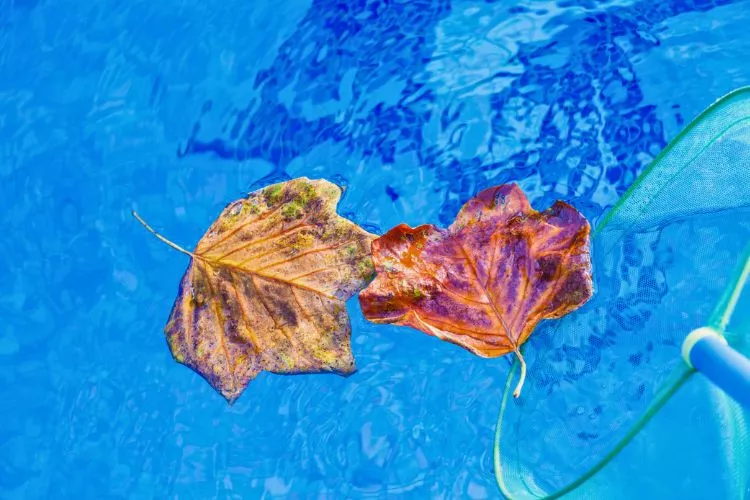
Ensure safety precautions like turning off pool equipment
First and foremost, turn off all pool equipment. This includes the pool pump, skimmers, and any automated cleaning systems you might have. It’s better to be safe than sorry, and besides, active equipment can interfere with your cleaning efforts.
Assemble all necessary tools for efficient cleaning
Now, gather your weapons of choice. You don’t want to be in the middle of skimming only to realize you forgot to bring out the leaf rake. Make a checklist if you have to, but ensure you have:
- Pool Skimmer
- Pool Net
- Leaf Rake
- Pool Pole (telescopic, ideally)
- Pool Vacuum
- Waste Bag or Compost Pile
- Gloves and possibly goggles for added safety
Having all your tools at arm’s reach will not only speed up the process but also make it far less laborious.
Skimming the Surface
Skimming is the first line of defense in your battle against leaves. This simple yet effective technique will help you remove leaves and other debris floating on your pool’s surface before they sink and create a bigger headache.
Using skimmers to remove leaves floating on the water’s surface
Using a pool skimmer is relatively straightforward, but here are some tips to maximize its effectiveness:
- Attach the Skimmer to the Pole: Securely attach the skimmer net to your telescopic pole. Ensure it is fastened tightly to avoid any mishaps during the cleaning process.
- Skim in a Strategic Pattern: Start from one end of the pool and move towards the other end. This will prevent you from pushing leaves away or swirling them around in the water.
- Skim Slowly: Don’t rush the process. Move the skimmer slowly across the surface of the water to catch more leaves.
- Empty the Skimmer Frequently: Don’t wait until the skimmer is overflowing with leaves to empty it. Regularly empty the contents into a waste bag or compost pile.
The importance of regular skimming
Regular skimming is essential for maintaining a clean and inviting pool. It’s not just about aesthetics; it also helps prevent the leaves from sinking to the bottom, where they can stain the pool floor or clog your pool’s filtration system.
Aim to skim your pool daily, or at the very least, every other day. Regular skimming will make the task less daunting and keep your pool in top-notch condition.
Manual Netting
Sometimes, despite your best efforts to prevent leaf accumulation, you’re going to find leaves at the bottom of your pool. In these instances, manual netting comes to the rescue. It’s hands-on, sure, but it’s also incredibly effective when done correctly.
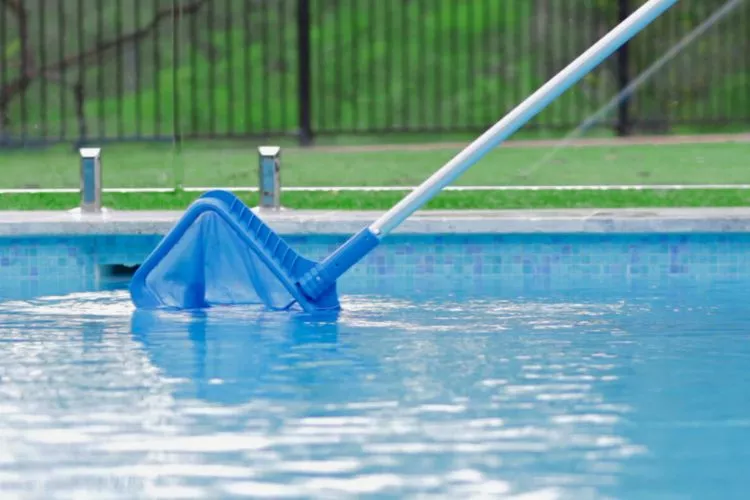
Step-by-step instructions for using a pool net to catch leaves
- Select the Right Net: Ensure your pool net has holes small enough to trap leaves but large enough to allow water to pass through.
- Attach the Net to the Pole: Just as with the skimmer, securely attach your pool net to a telescopic pole. Make sure it’s snug and secure.
- Plan Your Approach: Start from the shallow end of the pool and work your way toward the deeper sections. This will allow you to adjust to the weight of the net and the leaves you collect.
- Use a Sweeping Motion: Move the net across the bottom of the pool in a sweeping motion. Be sure to lift the net out of the water after each sweep to avoid pushing the leaves away.
- Check and Empty the Net: After several sweeps, check the net. Once it’s full of leaves, empty the contents into a waste bag or compost pile.
Tips to avoid pushing leaves away while netting
- Gentle Movements: Use slow and controlled movements to avoid pushing leaves away. Quick or jerky motions can create currents that disperse the leaves.
- Shallow to Deep: Start in the shallow end and move towards the deep end. This ensures you’re not pushing leaves into an area you’ve already cleaned.
- Limit Water Disruption: Try not to disrupt the water too much as it will make the leaves harder to catch.
Cleaning Skimmer Baskets and Pump Strainer
Your pool’s skimmer baskets and pump strainer do a lot of heavy lifting when it comes to trapping leaves. While you’re busy skimming and netting, they’re passively capturing floating and submerged debris, making your job easier. But they also need some love and attention to keep doing their job effectively.
The role of skimmer baskets and pump strainers in leaf removal
Skimmer baskets are typically located on the side of your pool and directly connected to the skimmer. They catch leaves and other debris before they get to your pool’s filtration system. Pump strainers, on the other hand, are situated right before the pool pump and catch any debris that may have bypassed the skimmer baskets.
Both of these components are crucial for reducing the strain on your pool’s filtration system, preventing potential clogs, and ultimately, saving you time and money.
How to clean and empty them?
- Turn Off Pool Equipment: Always turn off all pool equipment before you begin. Safety first!
- Remove the Skimmer Lid: Carefully remove the lid to your skimmer basket. Some skimmers have a twist-off lid, while others might just lift off.
- Extract the Basket: Lift out the skimmer basket. Be cautious as it may be heavy with debris.
- Empty and Rinse: Empty the trapped leaves into a waste bag and rinse the basket with a hose to remove smaller particles.
- Clean the Pump Strainer: Open the lid on your pump strainer and remove the basket, following the same empty-and-rinse procedure.
- Replace and Secure: Once cleaned, place the baskets back into their respective holders and secure the lids.
Pool Vacuuming
Okay, you’ve skimmed, you’ve netted, but what about those leaves that think they’re smart by sinking to the bottom? That’s where your trusty pool vacuum comes in. This piece of equipment is your go-to for a sparkling clean pool, from surface to floor.
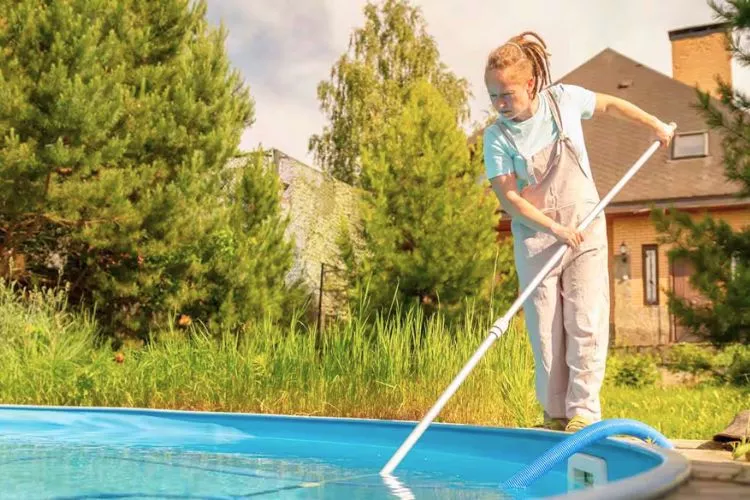
Using a pool vacuum to remove leaves settled at the pool bottom
Vacuuming the pool isn’t rocket science, but there’s an art to doing it efficiently. Here’s how you do it:
- Attach the Vacuum: Secure the vacuum head to the telescopic pole and attach the vacuum hose to the vacuum head.
- Prime the Hose: Submerge the vacuum hose to fill it with water, which helps in creating the suction.
- Connect to Skimmer: Once the hose is filled with water, plug it into the skimmer inlet.
- Start Vacuuming: Turn the pool pump back on to initiate suction. Now, you’re ready to start vacuuming. Move the vacuum head slowly across the pool floor, being careful not to stir up the leaves.
Vacuuming in sections for effective cleaning
Don’t attempt to vacuum your whole pool in one grand swoop. Break it down into sections. This makes sure that every inch gets the attention it deserves and allows you to focus on areas where leaves have accumulated the most. Trust me, methodical is the way to go here.
- Section by Depth: Start with the shallow end and move toward the deep end.
- Overlap Movements: For the most thorough cleaning, make sure to slightly overlap each pass with the vacuum.
- Time Management: Don’t rush through it. Give each section enough time for optimal cleanliness.
Pro Tips for Efficient Leaf Removal
So you’ve got the basics down, but how about some insider tricks to make your life even easier? After all, prevention is better than cure, right? Let’s dive into some tried-and-true methods that can save you time and effort in the long run.
Regular Maintenance
Ah, the cornerstone of any hassle-free pool experience—regular maintenance. It’s like brushing your teeth; do it consistently, and you’ll avoid a whole lot of trouble down the line.
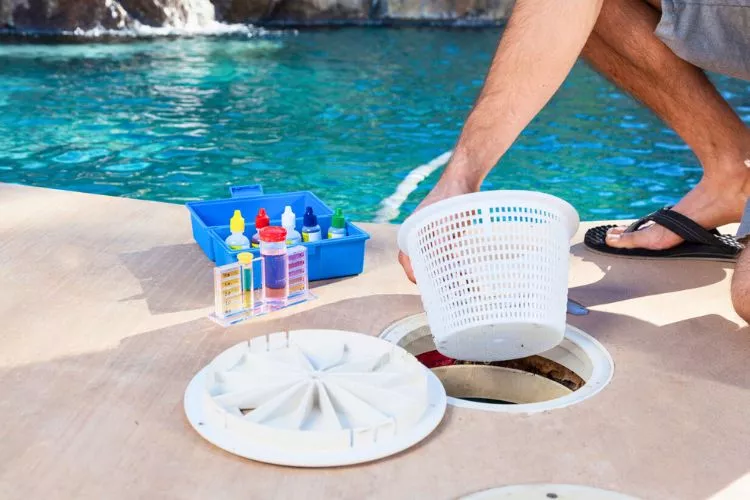
The importance of daily or weekly maintenance routines.
Here’s the thing: a pool is not a “set it and forget it” kind of deal. Daily or at least weekly maintenance routines are your best friends in pool care. Depending on your location and the number of trees around, you might need to adjust the frequency.
Here’s a simple outline to keep you on track:
- Daily: Quick surface skimming and basket cleaning.
- Weekly: More thorough skimming, vacuuming, and checking water chemistry.
Preventing leaves from accumulating in the first place
When it comes to leaves, prevention is key. Consider it like this: every leaf you stop from falling into your pool is one less leaf you have to remove later. Simple as that.
- Use Windbreaks: Installing a fence or planting some hedges upwind of your pool can reduce the leaves that get blown in.
- Pool Cover: When the pool isn’t in use, covering it can prevent a lot of debris from entering.
- Regular Trimming: Keep an eye on those overhanging branches and give them a haircut as needed.
Trimming Nearby Trees and Plants
If you’ve got trees and shrubs giving your pool some shade, that’s great—but remember, they’re also the primary suspects in your leafy dilemma. Here’s how to keep them in check without losing the green scenery you love.
Pruning regularly to minimize leaf shedding
Pruning isn’t just for garden enthusiasts; it’s a necessary pool care task too. Regular trimming minimizes the leaf-shed and keeps your pool’s water clear. But don’t just go hacking away; there’s a method to the madness.
- Know When to Trim: Every plant has its optimal trimming season. For instance, most deciduous trees are best pruned in late winter or early spring.
- Use the Right Tools: A pair of gardening shears for smaller branches and a saw for the bigger ones should do the trick. Always wear gloves and safety goggles.
Create a larger buffer zone between trees and the pool
Think of this as your pool’s personal space—a buffer zone, if you will. The greater the distance between the greenery and your pool, the fewer leaves you’ll have to contend with. Here’s how to make it happen:
- Strategic Planting: If you’re still in the planning stage of your yard, consider placing trees and shrubs farther from your pool.
- Relocate Existing Plants: Some smaller shrubs and potted plants can be easily relocated to create that much-needed buffer.
Using Pool Covers
Ah, the pool cover—a simple yet genius invention that works while you’re asleep, at work, or away on vacation. It’s the unsung hero of pool care, and here’s why you need one in your life, especially if you’re dealing with a relentless leaf problem.
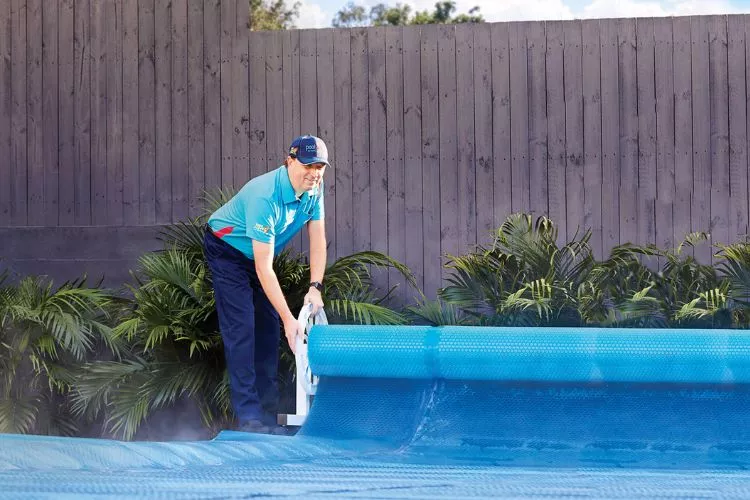
Benefits of using pool covers during off-season or when not in use
The offseason can turn your pool into a veritable leaf swamp if you’re not careful. But with a pool cover, you can maintain your pool as a refreshing oasis rather than a leafy lagoon.
- Protection from Elements: Not just leaves, but also dirt, rain, and even snow will be kept at bay.
- Chemical Preservation: A cover helps in retaining the chemical balance of your pool, reducing the need for constant adjustments.
- Safety: Accidentally falling into a pool is a non-issue when it’s covered. Just make sure it’s a safety-certified cover, especially if you have kids or pets.
Reduction in leaf accumulation
Let’s cut to the chase: A pool cover is your first line of defense against those pesky leaves. They’ll collect on top, and you can just whisk them away—simple as that.
- Effort Reduction: Imagine all the time you’ll save from skimming and vacuuming.
- Expense Reduction: Less debris means less frequent need for filter cleaning and chemical rebalancing, which translates to cost savings in the long run.
Frequently Asked Questions (fAQs)
How often should I skim my pool to keep leaves at bay?
Skim your pool at least once a day if you have a heavy leaf problem. Otherwise, 3-4 times a week should suffice for moderate leaf accumulation.
Can I use a regular garden net to clean my pool?
Technically yes, but a specialized pool net is recommended. Garden nets may not be durable enough and could potentially damage your pool’s surface.
What can I do if leaves clog my pool’s filters?
Turn off the pump, remove the filter basket, and manually clean out the leaves. Reinstall and restart your pump. If clogs persist, consult a professional.
Are there any pool vacuum alternatives for leaf removal?
Yes, manual nets and leaf rakes can be effective, albeit labor-intensive. There are also automated pool cleaners designed for leaf removal.
Conclusion
Keeping your pool leaf-free is more than an aesthetic choice—it’s essential for hygiene, water quality, and smooth operation of your pool’s equipment. Investing a little time in regular maintenance can save you bigger headaches down the line.
We’ve armed you with practical tips and strategies, so don’t wait. Take the plunge and commit to a cleaner, more inviting pool. We hope that this guide has been helpful.
You can read about similar topics here on our website. Check back again soon for more.


